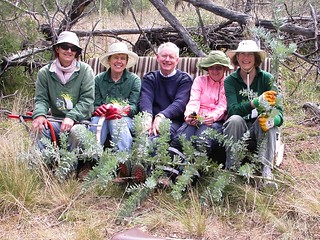
Taking a rest after work at the “Common” (from left) Jeanette Ruxton, Mount Ainslie Weeders, Liese Baker, Friends of Mount Majura (FoMM), Noel Birchall, FoMM, Annette Martin, Mount Ainslie Weeders, Jenni Marsh, FoMM. The “Common” is an area downhill of the saddle between Mount Ainslie and Mount Majura. Volunteers of the two parkCare groups work to remove large numbers of Cootamundra wattles and other woody weeds as well as dumped furniture, burned-out cars and other waste (Waltraud Pix, 17.04.2011).
Do your bit to protect our natural heritage at the working bee jointly hosted by the Friends of Mount Majura and the Mount Ainslie Weeders. Help tackle woody and other weeds in the grassy woodland downhill of the saddle between Mt Majura and Mt Ainslie.
When: Sunday, 21 April 2013 from 9.00 am to 1.00 pm
Where: Meet at the nature park entrance Kellaway Street / Phillip Avenue in Hackett; click here to view a map with the meeting point.
Bring and wear: Sun protection, sturdy boots, and body covering garden clothing.
We’ll provide the tools and refreshments.
Novice weeders are encouraged to be early for an induction on target weeds and on the save handling of equipment.
Enquires: phone 6247 7515 or e-mail admin@majura.org
Download this poster for event promotion
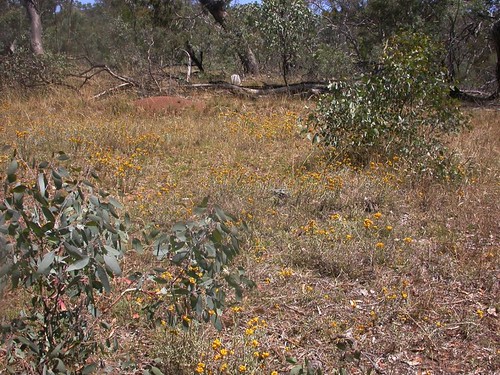
Yellow Buttons are spreading in the grassy woodland below the saddle between Mt Ainslie and Mt Majura following the removal of woody and herbaceous weeds (Photograph Waltraud Pix, 28.12.2012).
This will be a Search and Destroy activity. We will be cutting and daubing any encountered woody weed such as Sweet Briar rose and Cootamundra wattle and the perennial herb Asparagus, which has invaded this grassy woodland site which we call the “Common”.
Control of woody weeds using the cut and daub method.
Cut stems close to ground level and immediately treat cut surface with herbicide glyphosate (Roundup or equivalent product) applied at high concentration e.g. 1 part glyphosate : 2 parts water; apply herbicide mix with spray.
The plant’s natural protective mechanism acts very quickly to seal off the cut surface which stops herbicide penetration into the sap stream. It is therefore important to treat the cut surface immediately, i.e. within 30 seconds after cut; the longer the treatment is delayed, the poorer the result will be. If necessary cut and treat each stem of a multi-stemmed plant separately to avoid delayed herbicide treatment.
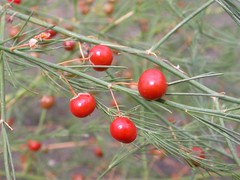
Aspargus officinalis, red berry fruits of a female plant; Mt Ainslie nature reserve (Waltraud Pix, 01.02.2013)
Asparagus
The herbaceous perennial plant, native to Europe, western Asia and North Africa, is widely cultivated as a vegetable crop. The shoots appear in spring, and – if not harvested – grow up to 1.5m tall stems. Female plants produce red berry fruits which are poisonous to humans and eaten by birds. Cultivation of Asparagus in gardens: ensure you grow male plants only – male shoots are as delicious as female berry producing plants. Click here for more information on Asparagus.
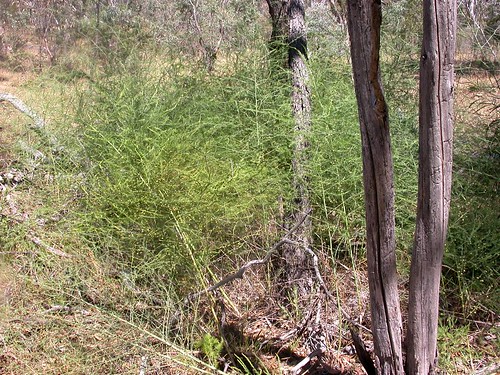
Asparagus officinalis, Mt Ainslie nature park (Waltraud Pix, 28.12.2012)
Asparagus, native to Europe, North Africa and western Asia, is widely cultivated for its edible green shoots (spears). The perennial, up to 1.5 m high herb dies back in winter and produces a succession of shoots through late spring and early summer. The “leaves” are in fact needle-like modified stems (cladodes) born in the axils of scale-like leaves. Asparagus can become a weed; the seeds are dispersed by birds eating the berries.

Sweet Briar, Rosa rubiginosa, a native of Europe and West Asia, is a major weed particularly of dry and hilly disturbed land. The seeds are spread by birds and foxes which eat the red fleshy fruits (rose hips). Briars were introduced to Australia as garden and hedge plants in the early 1800s (Photograph Waltraud Pix, 23.11.2011).
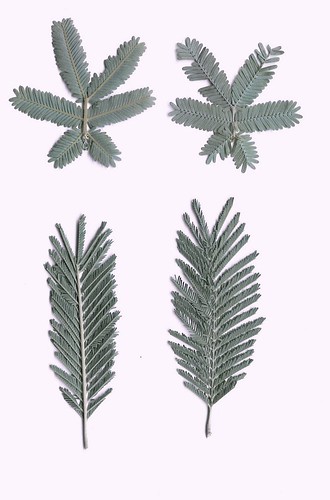
The Cootamundra Wattle, Acacia baileyana is one of the woody weeds which we control in the Mount Majura and Mount Ainslie nature reserves. The species does not naturally occur in Canberra and was introduced to the ACT as a garden plant. The highly invasive species is now widespread in Namadgi National Park and the suburban nature reserves of the ACT.
How to tell-apart from look-a-likes. The compound blueish-grey-green leaves of a Cootamundra wattle (top in the left panel) resemble those of the local species Silver wattle , Acacia dealbata (bottom). The leaves of Cootamundra wattles have 3-4 pairs of leaflets arranged along the leaf stem, the lowest pair is shorter and embraces the branch to which the leaf is attached. The leaves of Silver wattles have 8-20 pairs of leaflets arranged along to the leaf stem and the lowest pair does not embrace the branch.
To view common woody weeds of Mt Majura and Mt Ainslie click on the FoMM Woody Weeds Flickr Group.


